An Integrated Modelling Approach to Study Future Water Demand Vulnerability in the Montargil Reservoir Basin, Portugal
Abstract
1. Introduction
2. Materials and Methods
2.1. Study Area
2.2. Integrated Modelling Approach
2.2.1. Basin Model
2.2.2. Reservoir Modelling
2.2.3. Climate Models
2.3. Performance Indicators
3. Results and Discussion
3.1. Basin Modelling
3.1.1. Calibration and Validation
3.1.2. Water Availability
3.2. Reservoir Modelling
3.2.1. Validation
3.2.2. Water Availability
- -
- Assuming the average water demand in the past 10 years;
- -
- Considering the year with maximum water demand in the past 10 years, which correspond to a water demand increase of ~30% when compared with the average year. The second water demand scenario reflects the increase of irrigation in the Sorraia basin since water is mainly used for this purpose.
4. Conclusions and Future Research
Author Contributions
Funding
Conflicts of Interest
References
- Townsend, C.R.; Uhlmann, S.S.; Matthaei, C.D. Individual and combined responses of stream ecosystems to multiple stressors. J. Appl. Ecol. 2008, 45, 1810–1819. [Google Scholar] [CrossRef]
- Hering, D.; Carvalho, L.; Argillier, C.; Beklioglu, M.; Borja, A.; Cardoso, A.C.; Duel, H.; Ferreira, T.; Globevnik, L.; Hanganu, J.; et al. Managing aquatic ecosystems and water resources under multiple stress—An introduction to the MARS project. Sci. Total Environ. 2015, 503–504, 10–21. [Google Scholar] [CrossRef] [PubMed]
- Segurado, P.; Almeida, C.; Neves, R.; Ferreira, M.T.; Branco, P. Understanding multiple stressors in a Mediterranean basin: Combined effects of land use, water scarcity and nutrient enrichment. Sci. Total Environ. 2018, 624, 1221–1233. [Google Scholar] [CrossRef] [PubMed]
- Ragab, R.; Prudhomme, C. SW—Soil and Water: Climate Change and Water Resources Management in Arid and Semi-arid Regions: Prospective and Challenges for the 21st Century. Biosyst. Eng. 2002, 81, 3–34. [Google Scholar] [CrossRef]
- Jørgen, E.O.; Bindi, M. Consequences of climate change for European agricultural productivity, land use and policy. Eur. J. Agron. 2002, 16, 239–262. [Google Scholar]
- Van Vuuren, D.P.; Edmonds, J.; Kainuma, M.; Riahi, K.; Thomson, A.; Hibbard, K.; Hurtt, G.C.; Kram, T.; Krey, V.; Lamarque, J.F.; et al. The representative concentration pathways: An overview. Clim. Chang. 2011, 109, 5. [Google Scholar] [CrossRef]
- IPCC. Climate Change 2013: The Physical Science Basis; Contribution of Working Group I to the Fifth Assessment Report of the Intergovernmental Panel on Climate Change; Stocker, T.F., Qin, D., Plattner, G.-K., Tignor, M., Allen, S.K., Boschung, J., Nauels, A., Xia, Y., Bex, V., Midgley, P.M., Eds.; Cambridge University Press: Cambridge, UK; New York, NY, USA, 2013; 1535p. [Google Scholar]
- Iglesias, A.; Garrote, L.; Flores, F.; Moneo, M. Challenges to Manage the Risk of Water Scarcity and Climate Change in the Mediterranean. Water Resour. Manag. 2007, 21, 775–788. [Google Scholar] [CrossRef]
- Giorgi, F.; Lionello, P. Climate change projections for the Mediterranean region. Glob. Planet. Chang. 2008, 63, 90–104. [Google Scholar] [CrossRef]
- Botelho, F.; Ganho, N. Dinâmica Anticiclónica Subjacente à Seca de 2004/2005 em Portugal Continental; VI Seminário Latino Americano de Geografia Física, II Seminário Ibero-americano de Geografia Física, Departamento de Geografia e Centro de Estudos de Geografia e Ordenamento do Território (CEGOT), Faculdade de Letras, Universidade de Coimbra: Coimbra, Portugal, 2010. [Google Scholar]
- Santos, F.D.; Miranda, P. Alterações Climáticas em Portugal. Cenários, Impactos e Medidas de Adaptação—Projecto SIAM II; Gradiva: Lisboa, Portugal, 2006. [Google Scholar]
- Valverde, P.; Serralheiro, R.; Carvalho, M.; Maia, M.; Oliveira, B.; Ramos, V. Climate change impacts on irrigated agriculture in the Guadiana river basin (Portugal). Agric. Water Manag. 2015, 152, 17–30. [Google Scholar] [CrossRef]
- Silva, H.; Martin-Dominguez, I.; Alarcón-Herrera, M.; Granados-Olivas, A. Mathematical Modelling for the Integrated Management of Water Resources in Hydrological Basins. Water Resour. Manag. 2008, 23, 721–730. [Google Scholar] [CrossRef]
- Skoulikaris, C. Mathematical Modeling Applied to Integrated Water Resources Management: The Case of Mesta-Nestos Basin. Ph.D. Thesis, École Nationale Supérieure des Mines de Paris, Paris, France, 2008. [Google Scholar]
- Brito, D.; Neves, R.; Branco, M.A.; Gonçalves, M.C.; Ramos, T.B. Integrated modelling for water quality management in a eutrophic reservoir in south-eastern Portugal. Environ. Earth Sci. 2018, 77, 40. [Google Scholar] [CrossRef]
- Labadie, J.W. MODSIM: Decision Support System for Integrated River Basin Management. In Proceedings of the International Congress on Environmental Modelling and Software, Burlington, VT, USA, 9–13 July 2006; Volume 15. [Google Scholar]
- Lettenmaier, D.P.; Alan, F.; Hamlet, T.B.; Se-Yeun, L. Evaluation of Alternative Models and Methods for Prediction of Hydropower Resources in California and the Pacific Northwest; CEC-500-2007-104; California Energy Commission, PIER Energy-Related Environmental Research Program: Sacramento, CA, USA, 2008. [Google Scholar]
- Hashimoto, T.; Stedinger, J.R.; Loucks, D.P. Reliability, resiliency, and vulnerability criteria for water resource system performance evaluation. Water Resour. Res. 1982, 18, 14–20. [Google Scholar] [CrossRef]
- Jinno, K.; Zongxue, X.; Kawamura, A.; Tajiri, K. Risk assessment of a water supply system during drought. Water Resour. Dev. 1995, 11, 185–204. [Google Scholar] [CrossRef]
- Brito, D.; Campuzano, F.J.; Sobrinho, J.; Fernandes, R.; Neves, R. Integrating operational watershed and coastal models for the Iberian Coast: Watershed model implementation—A first approach. Estuar. Coast. Shelf Sci. 2015, 167, 138–146. [Google Scholar] [CrossRef]
- Mateus, V.; Brito, D.; Leitão, P.C.; Caetano, M. Produção e Utilização de Cartografia Multi-Escala Derivada Através dos Sensores LISSIII, AWiFS e MERIS para Modelação da Qualidade da Água para a Bacia Hidrográfica do Rio Tejo; Conferência Nacional de Cartografia e Geodesia: Lisboa, Portugal, 2009. [Google Scholar]
- IUSS Working Group. World Reference Base for Soil Resources 2014. International Soil Classification System for Naming Soils and Creating Legends for Soil Maps; World Soil Resources Reports No. 106; FAO: Rome, Italy, 2014. [Google Scholar]
- Neitsch, S.L.; Arnold, J.G.; Kiniry, J.R.; Williams, J.R. Soil and Water Assessment Tool; Theoretical Documentation; Version 2009; Texas Water Resources Institute; Technical Report No. 406; Texas A&M University System: College Station, TX, USA, 2011. [Google Scholar]
- Neves, R.J. A Bidimensional Model for Residual Circulation in Coastal Zones. Application to the Sado Estuary. Annalles Geophysicae 1985, 3–4, 465–472. [Google Scholar]
- Dunne, J.P.; John, J.G.; Shevliakova, E.; Stouffer, R.J.; Krasting, J.P.; Malyshev, S.L.; Milly, P.C.; Sentman, L.T.; Adcroft, A.J.; Cooke, W.; et al. GFDL’s ESM2 Global Coupled Climate–Carbon Earth System Models. Part II: Carbon System Formulation and Baseline Simulation Characteristics. J. Clim. 2013, 26, 2247–2267. [Google Scholar] [CrossRef]
- Dufresne, J.L.; Foujols, M.A.; Denvil, S.; Caubel, A.; Marti, O.; Aumont, O.; Balkanski, Y.; Bekki, S.; Bellenger, H.; Benshila, R. Climate change projections using the IPSL-CM5 Earth System Model: From CMIP3 to CMIP5. Clim. Dyn. 2013, 40, 2123–2165. [Google Scholar] [CrossRef]
- Almeida, C.; Ramos, T.; Segurado, P.; Branco, P.; Neves, R.; Oliveira, R.P. Water Quantity and Quality under Future Climate and Societal Scenarios: A Basin-Wide Approach applied to the Sorraia River, Portugal. Water 2018, 10, 1186. [Google Scholar] [CrossRef]
- Allen, R.G.; Pereira, L.S.; Raes, D.; Smith, M. Crop Evapotranspiration—Guidelines for Computing Crop Water Requirements; Irrig. & Drain. Paper 56; FAO: Rome, Italy, 1998. [Google Scholar]
- Cardoso, J.C. Os Solos de Portugal. Sua Classificação, Caracterização e Génese. 1—A Sul do Rio Tejo; Direcção-Geral dos Serviços Agrícolas: Lisboa, Portugal, 1965. [Google Scholar]
- Serviço Nacional de Informação dos Recursos Hídricos (SNIRH—Portuguese National Institute of Water Resources). Available online: http://snirh.apambiente.pt/ (accessed on 30 July 2017).
- Coelho, H.S.; Neves, R.R.; Leitão, P.C.; Martins, H.; Santos, A.P. The slope current along the western European margin: A numerical investigation. Bol. Inst. Esp. Oceanogr. 1999, 15, 61–72. [Google Scholar]
- Deus, R.; Brito, D.; Kenov, I.A.; Lima, M.; Costa, V.; Medeiros, A.; Neves, R.; Alves, C.N. Three-dimensional model for analysis of spatial and temporal patterns of phytoplankton in Tucuruí reservoir, Pará, Brazil. Ecol. Model. 2013, 253, 28–43. [Google Scholar] [CrossRef]
- Franz, G.; Leitão, P.; Santos, A.; Juliano, M.; Neves, R. From regional to local scale modelling on the south-eastern Brazilian shelf: Case study of Paranaguá estuarine system. Brazil. J. Oceano 2016, 64, 277–294. [Google Scholar] [CrossRef]
- Faneca Sanchez, M.; Duel, H.; Sampedro, A.A.; Rankinen, K.; Holmberg, M.; Prudhomme, C.; Bloomfield, J.; Couture, J.M.; Panagopoulos, Y.; Ferreira, T.; Venohr, M.; Birk, S. Deliverable 2.1—Four Manuscripts on the Multiple Stressor Framework. Part 4: Report on the MARS Scenarios of Future Changes in Drivers and Pressures with Respect to Europe’s Water Resources. EU-Project MARS (Managing Aquatic Ecosystems and Water Resources under Multiple Stress). 2015. Available online: http://www.mars-project.eu/files/download/deliverables/MARS_D2.1_Four_manuscripts_on_the_multiple_stressor_framework.pdf (accessed on 10 November 2018).
- Birk, S.; Strackbein, J.; Faneca Sanchez, M.; Schmidt-Kloiber, A.; St. John, R. MARS Deliverable 8.4: Fact Sheets Including a Set of Illustrations. EU-Project MARS (Managing Aquatic Ecosystems and Water Resources under Multiple Stress) 2016. Available online: http://www.mars-project.eu/files/download/deliverables/MARS_D8.4_fact_sheets.pdf (accessed on 20 November 2018).
- Feld, C.K.; Segurado, P.; Gutiérrez-Cánovas, C. Analysing the impact of multiple stressors in aquatic biomonitoring data: A ‘cookbook’ with applications in R. Sci. Total Environ. 2016, 573, 1320–1339. [Google Scholar] [CrossRef]
- O’Neill, B.C.; Kriegler, E.; Riahi, K.; Ebi, K.L.; Hallegatte, S.; Carter, T.R.; Mathur, R.; van Vuuren, D.P. A new scenario framework for climate change research: The concept of shared socioeconomic pathways. Clim. Chang. 2014, 122, 387–400. [Google Scholar] [CrossRef]
- Riahi, K.; Van Vuuren, D.P.; Kriegler, E.; Edmonds, J.; O’neill, B.C.; Fujimori, S.; Bauer, N.; Calvin, K.; Dellink, R.; Fricko, O.; et al. The Shared Socioeconomic Pathways and their energy, land use, and greenhouse gas emissions implications: An overview. Glob. Environ. Chang. 2017, 42, 153–168. [Google Scholar] [CrossRef]
- Warszawski, L.; Frieler, K.; Huber, V.; Piontek, F.; Serdeczny, O.; Schewe, J. The Inter-Sectoral Impact Model Intercomparison Project (ISI–MIP): Project framework. Proc. Natl. Acad. Sci. USA 2014, 111, 3228–3232. [Google Scholar] [CrossRef] [PubMed]
- Hempel, S.; Frieler, K.; Warszawski, L.; Schewe, J.; Piontek, F. A trend-preserving bias correction—The ISI-MIP approach. Earth Syst. Dyn. 2013, 4, 219–236. [Google Scholar] [CrossRef]
- Moss, R.H.; Edmonds, J.A.; Hibbard, K.A.; Manning, M.R.; Rose, S.K.; van Vuuren, D.P.; Carter, T.R.; Emori, S.; Kainuma, M.; Kram, T.; et al. The next generation of scenarios for climate change research and assessment. Nature 2010, 463, 747–756. [Google Scholar] [CrossRef] [PubMed]
- Briak, H.; Moussadek, R.; Aboumaria, K.; Mrabet, R. Assessing sediment yield in Kalaya gauged watershed (Northern Morocco) using GIS and SWAT model. Int. Soil Water Conserv. Res. 2016, 4, 177–185. [Google Scholar] [CrossRef]
- Bucak, T.; Trolle, D.; Andersen, H.E.; Thodsen, H.; Erdoğan, S.; Levi, E.E.; Filiz, N.; Jeppesen, E.; Beklioğlu, M. Future water availability in the largest freshwater Mediterranean lake is at great risk as evidenced from simulations with the SWAT model. Sci. Total Environ. 2017, 581–582, 413–425. [Google Scholar] [CrossRef] [PubMed]
- Dechmi, F.; Burguete, J.; Skhiri, A. SWAT application in intensive irrigation systems: Model modification, calibration and validation. J. Hydrol. 2012, 470–471, 227–238. [Google Scholar] [CrossRef]
- Panagopoulos, Y.; Makropoulos, C.; Mimikou, M. Reducing surface water pollution through the assessment of the cost-effectiveness of BMPs at different spatial scales. J. Environ. Manag. 2011, 92, 2823–2835. [Google Scholar] [CrossRef] [PubMed]
- García-Ruiz, J.M.; López-Moreno, J.I.; Vicente-Serrano, S.M.; Lasanta–Martínez, R.; Beguería, S. Mediterranean water resources in a global change scenario. Earth-Sci. Rev. 2011, 105, 121–139. [Google Scholar] [CrossRef]
- De Luis, M.; González-Hidalgo, J.C.; Longares, L.A.; Stepanek, P. Seasonal precipitation trends in the Mediterranean Iberian Peninsula in second half of 20th century. Int. J. Climatol. 2009, 29, 1312–1323. [Google Scholar] [CrossRef]
- Simionesei, L.; Ramos, T.B.; Oliveira, A.R.; Jongen, M.; Darouich, H.; Weber, K.; Proença, V.; Domingos, T.; Neves, R. Modeling Soil Water Dynamics and Pasture Growth in the Montado Ecosystem Using MOHID Land. Water 2018, 10, 489. [Google Scholar] [CrossRef]
- Ramos, T.B.; Simionesei, L.; Jauch, E.; Almeida, C.; Neves, R. Modelling soil water and maize growth dynamics influenced by shallow groundwater conditions in the Sorraia Valley region, Portugal. Agric. Water Manag. 2017, 185, 27–42. [Google Scholar] [CrossRef]
- Lee, R.M.; Biggs, T.W.; Fang, X. Thermal and Hydrodynamic Changes under a Warmer Climate in a Variably Stratified Hypereutrophic Reservoir. Water 2018, 10, 1284. [Google Scholar] [CrossRef]
- Noori, R.; Yeh, H.-D.; Ashrafi, K.; Rezazadeh, N.; Bateni, S.M.; Karbassi, A.; Kachoosangi, F.T.; Moazami, S. A reduced-order based CE-QUAL-W2 model for simulation of nitrate concentration in dam reservoirs. J. Hydrol. 2015, 530, 645–656. [Google Scholar] [CrossRef]
- Simões, J.; Oliveira, R.P. Modelos De Gestão De Bacias Hidrográficas: Aplicação Do Iras-2010 E Do Aquatool Ao Aproveitamento Hidroagrícola Do Vale Do Sorraia. Recursos Hídricos 2014, 35, 29–39. [Google Scholar] [CrossRef]
- Simone, M.; Sušnik, J.; Trabucco, A.; Daccache, A.; Vamvakeridou-Lyroudia, L.; Renoldi, S.; Virdis, A.; Savić, D.; Assimacopoulos, D. Operational resilience of reservoirs to climate change, agricultural demand, and tourism: A case study from Sardinia. Sci. Total Environ. 2016, 543, 1028–1038. [Google Scholar]
- Mateus, C.; Tullos, D. Reliability, sensitivity, and uncertainty of reservoir performance under climate variability in basins with different hydrogeologic settings in Northwestern United States. Int. J. River Basin Manag. 2017, 15, 21–37. [Google Scholar] [CrossRef]
- Afzal, M.; Gagnon, A.S.; Mansell, M.G. The impact of projected changes in climate variability on the reliability of surface water supply in Scotland. Water Sci. Technol. Water Supply 2015, 15, 736–745. [Google Scholar] [CrossRef]
- Fiering, M.B. Estimates of resilience indices by simulation. Water Resour. Res. 1982, 18, 41–50. [Google Scholar] [CrossRef]
- Asefa, T.; Clayton, J.; Adams, A.; Anderson, D. Performance evaluation of a water resources system under varying climatic conditions: Reliability, resilience, vulnerability and beyond. J. Hydrol. 2014, 508, 53–65. [Google Scholar] [CrossRef]
- Bates, B.C.; Kundzewicz, Z.W.; Wu, S.; Palutikof, J.P. (Eds.) Climate Change and Water; Technical Paper of the Intergovernmental Panel on Climate Change; IPCC Secretariat: Geneva, Switzerland, 2008; 210p. [Google Scholar]
- European Environment Agency (EEA). Vulnerability and Adaptation to Climate Change in Europe; EEA Technical Report No. 7/2005; European Environment Agency: Copenhagen, Denmark, 2005. [Google Scholar]
- Calbó, J. Possible Climate Change Scenarios with Specific Reference to Mediterranean Regions. In Water Scarcity in the Mediterranean: Perspectives Under Global Change; Sabater, S., Barceló, D., Eds.; Springer: Berlin/Heidelberg, Germany, 2010. [Google Scholar]
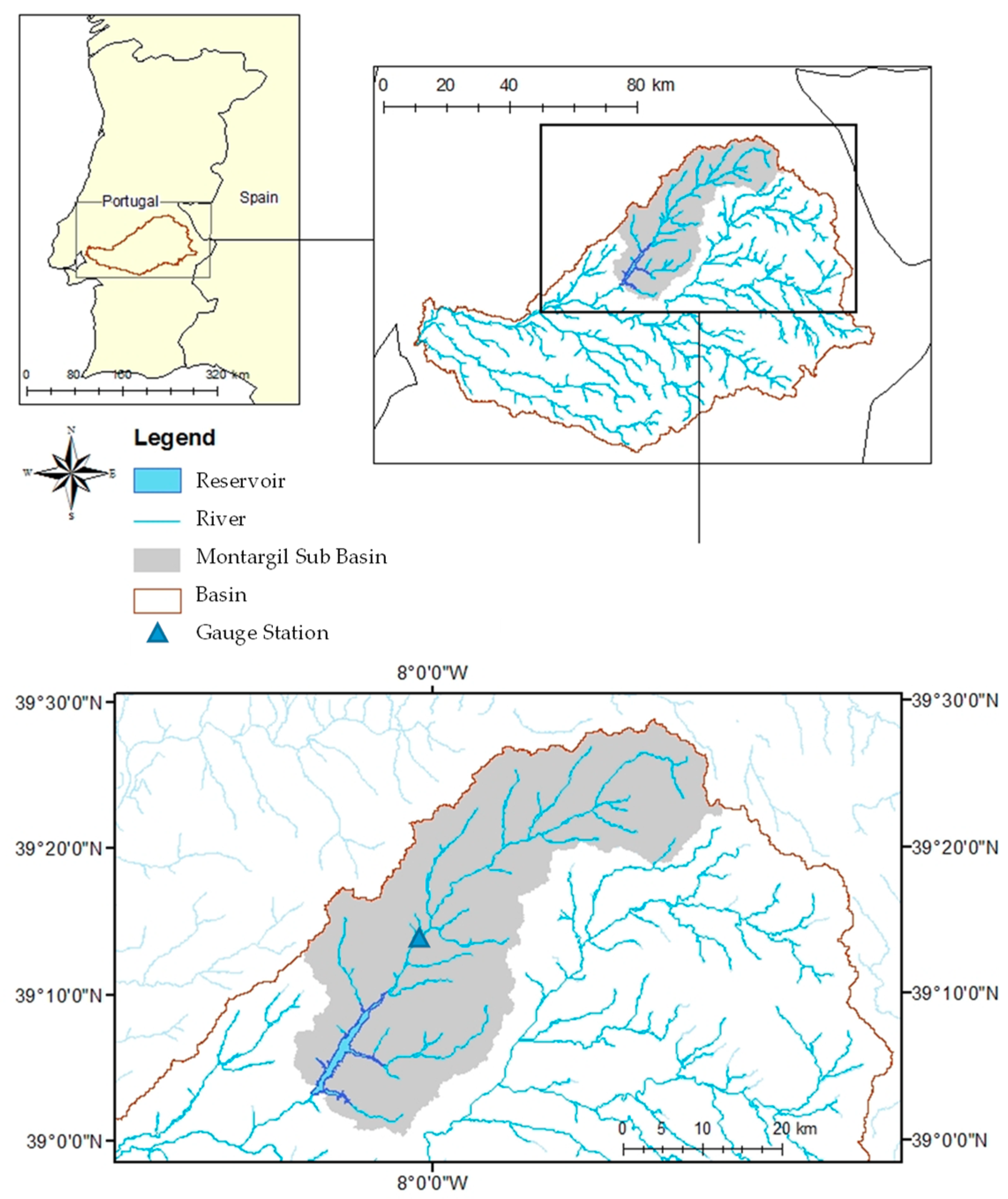

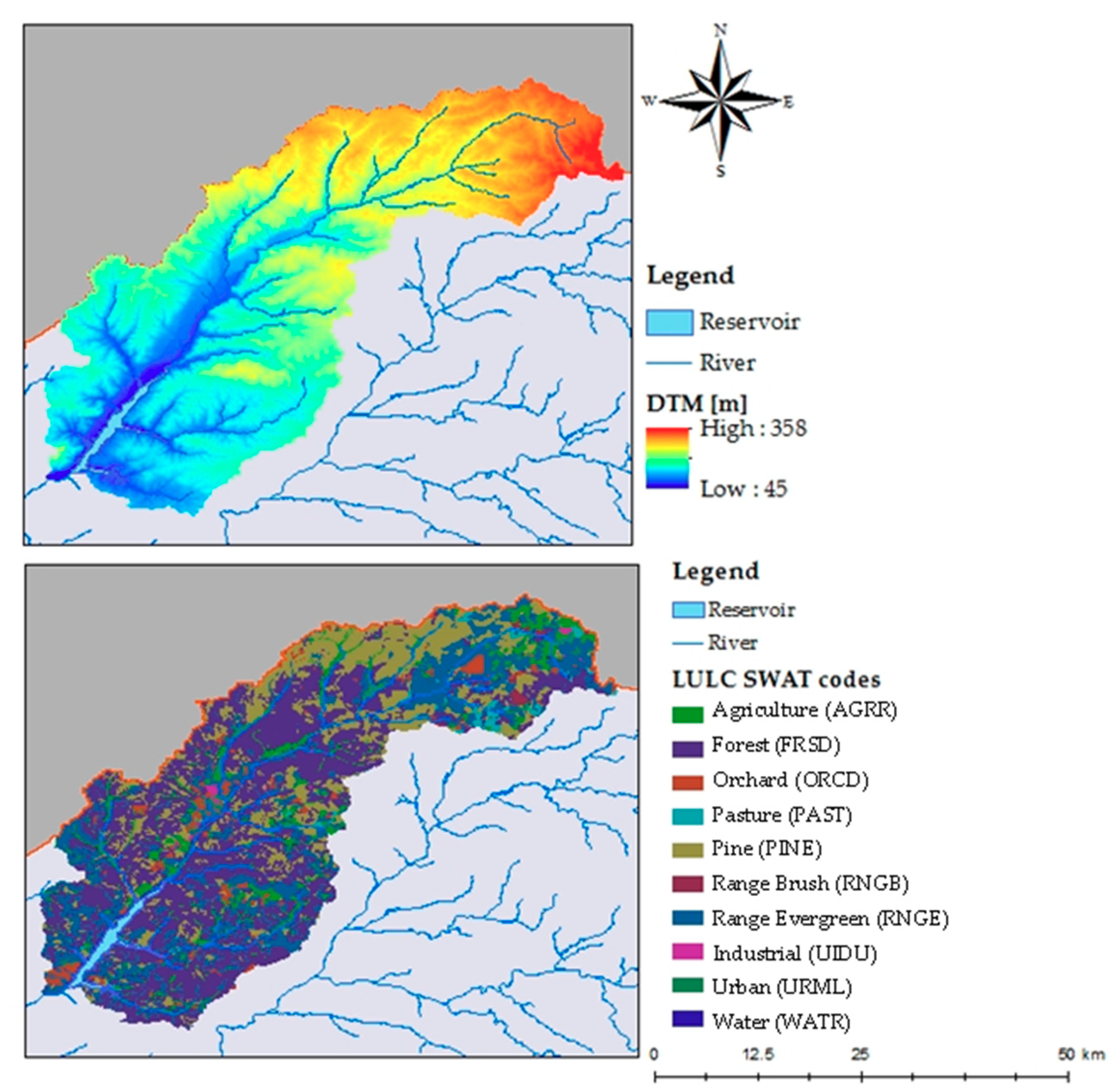
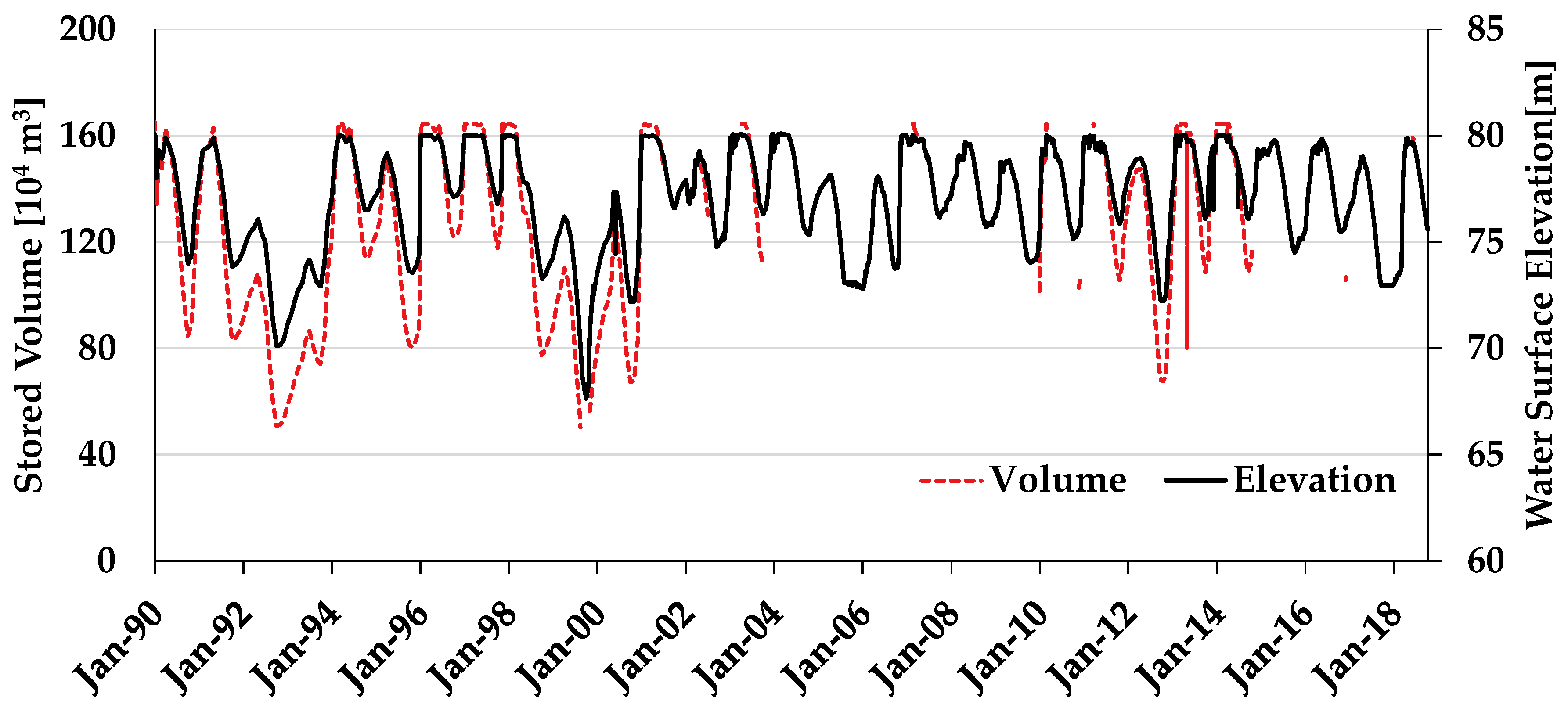
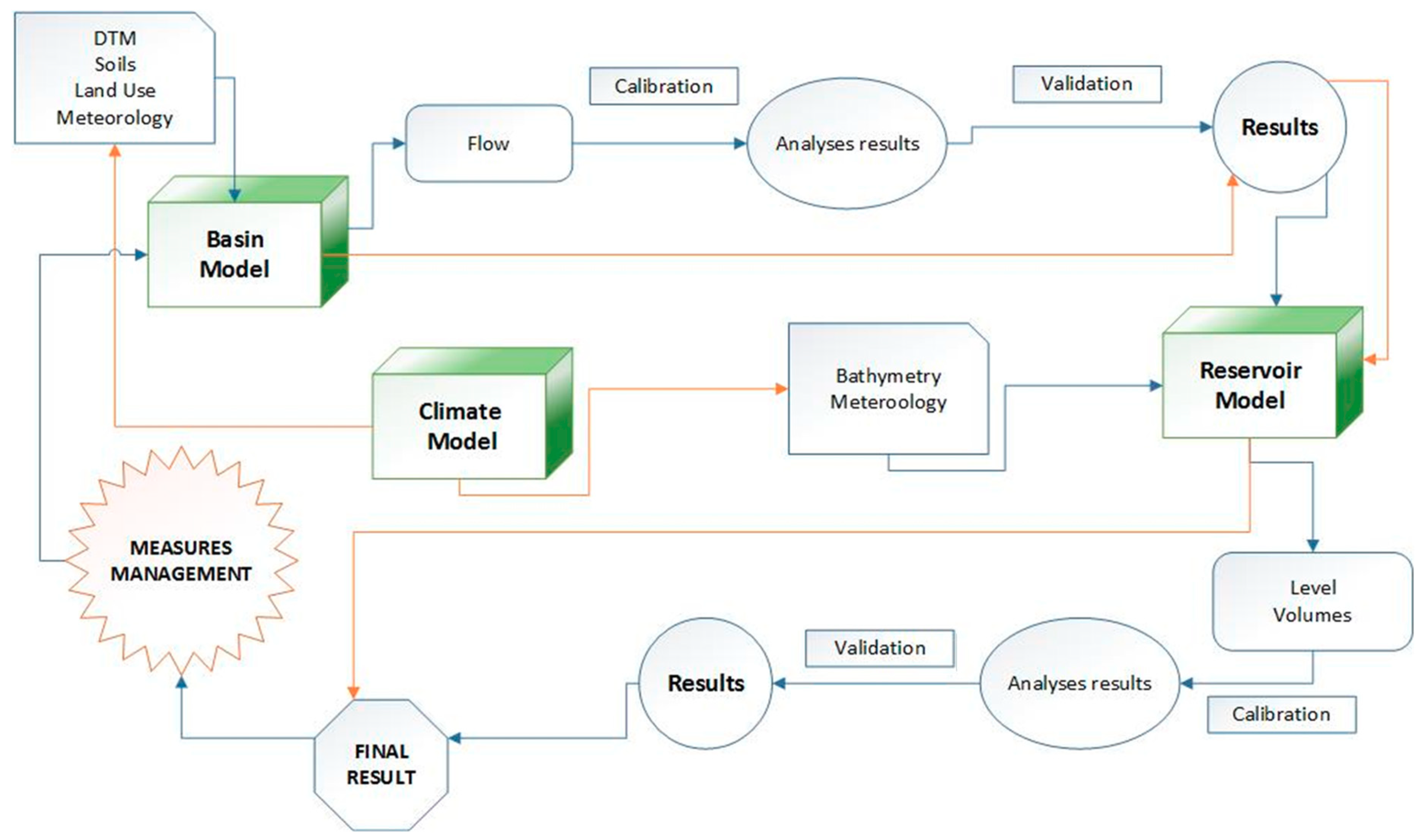
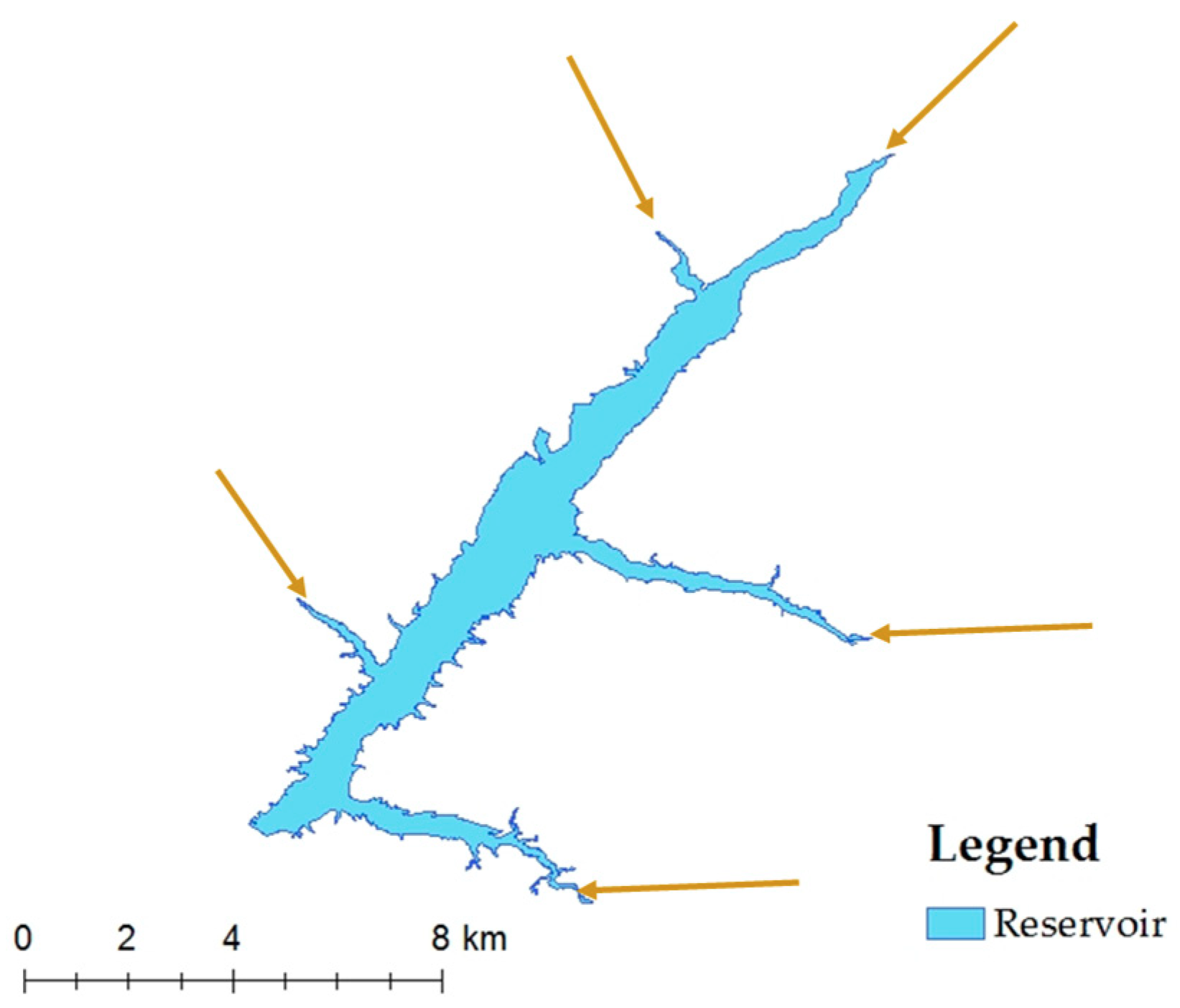
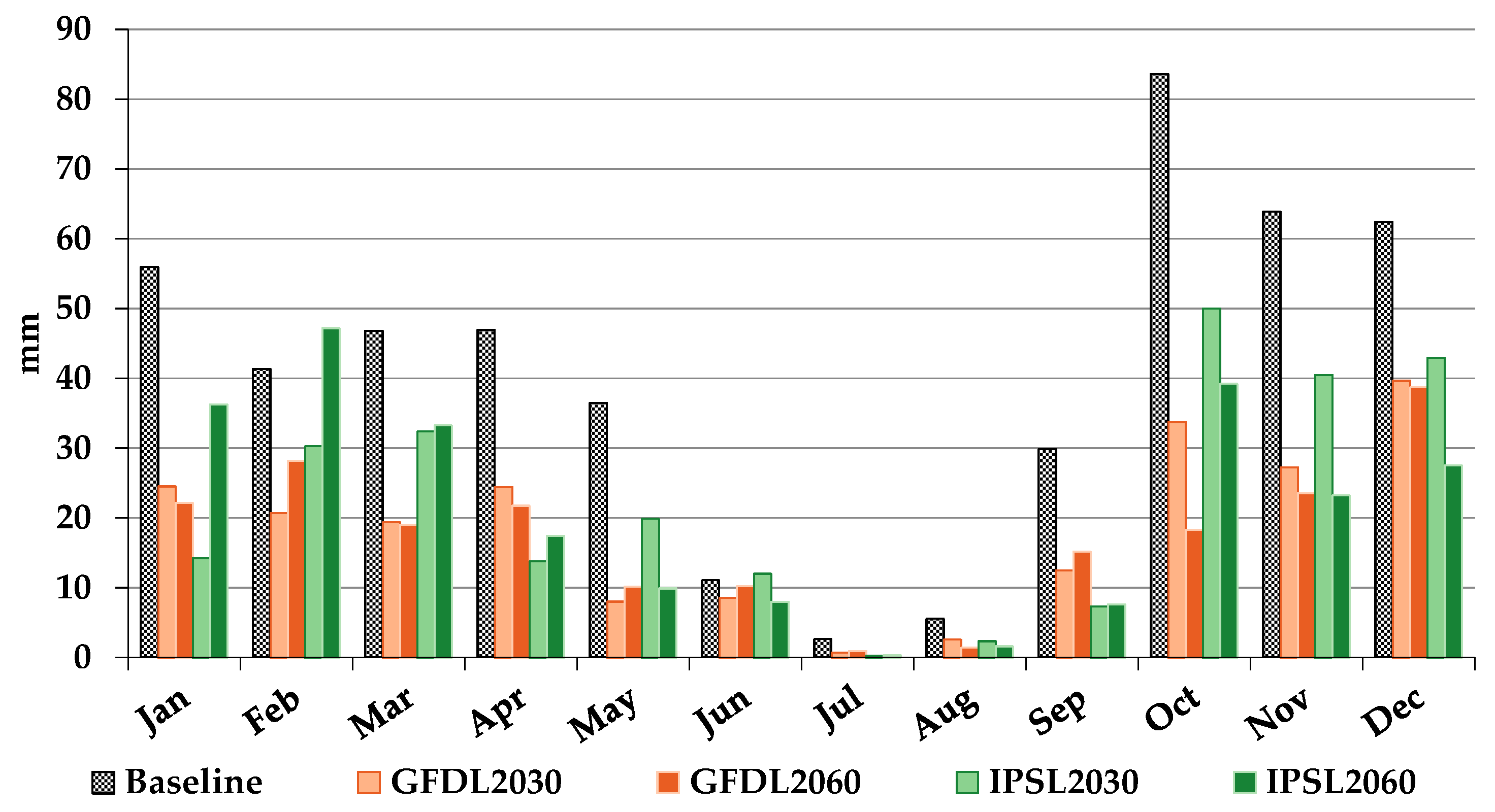
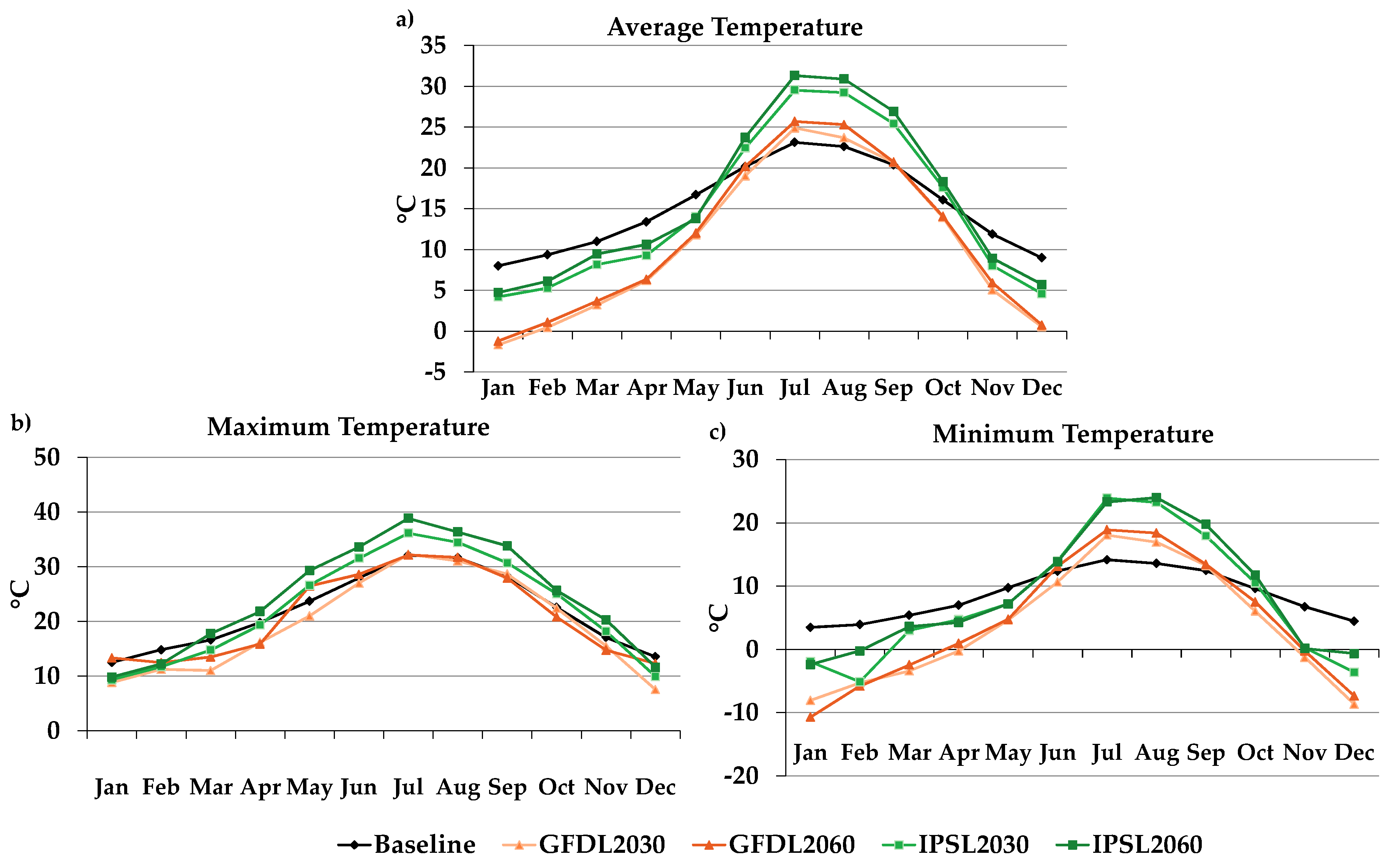
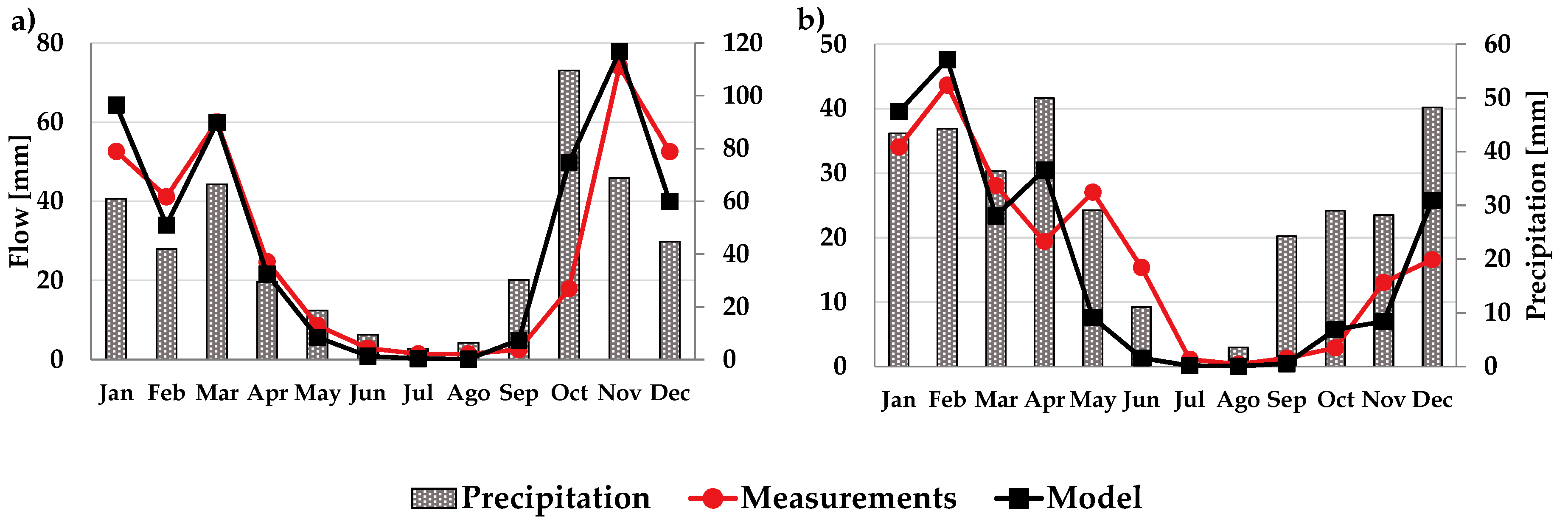
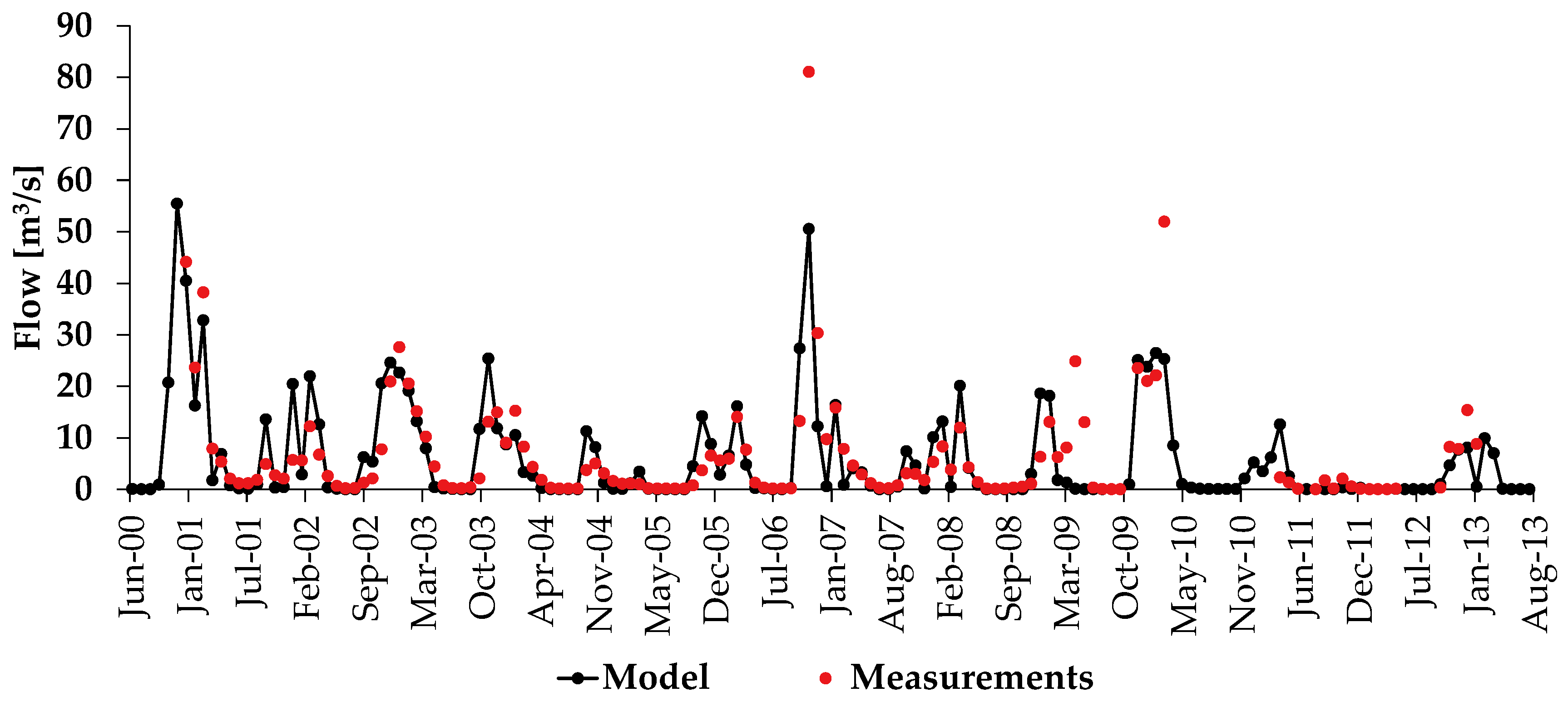

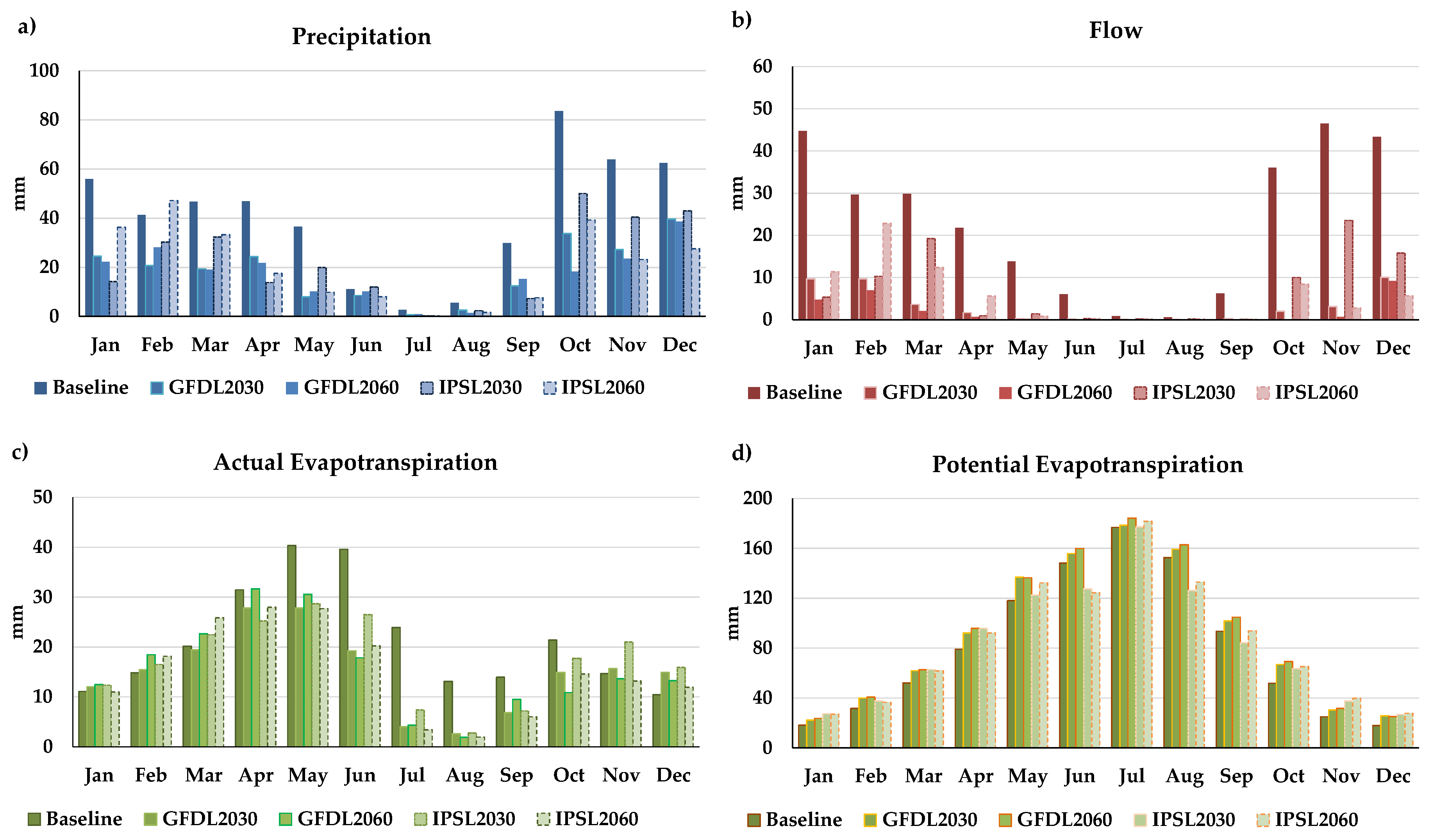
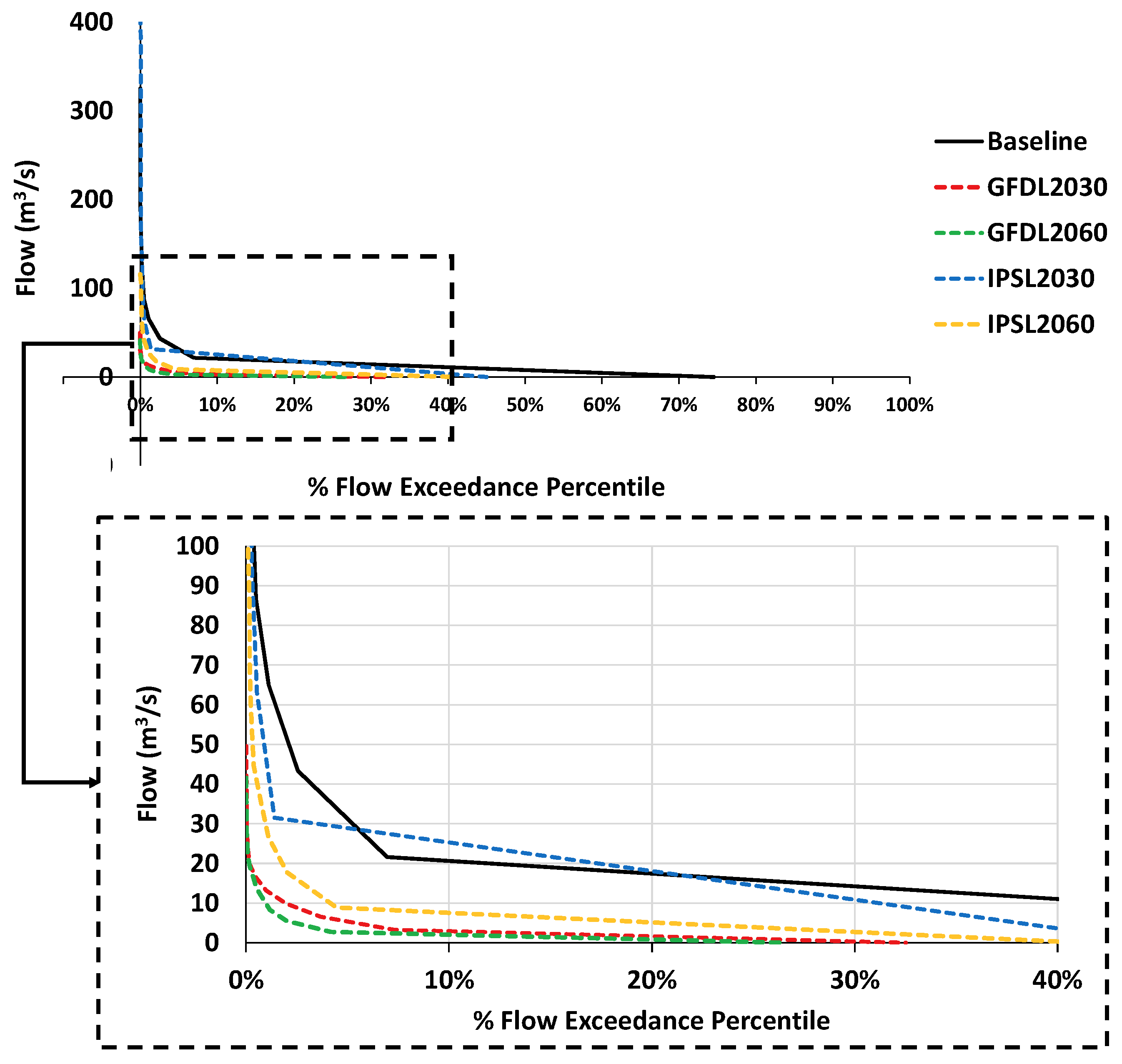
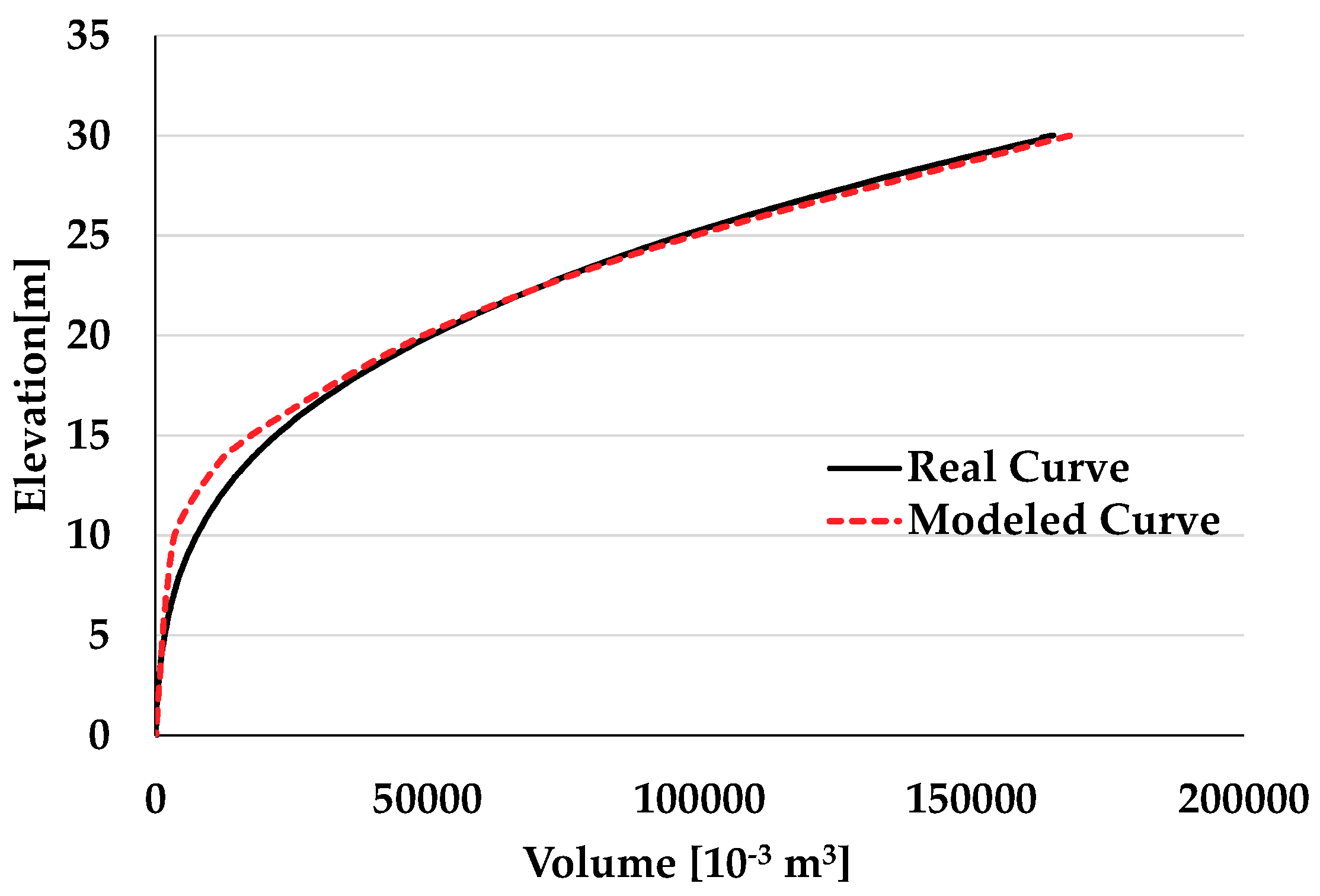
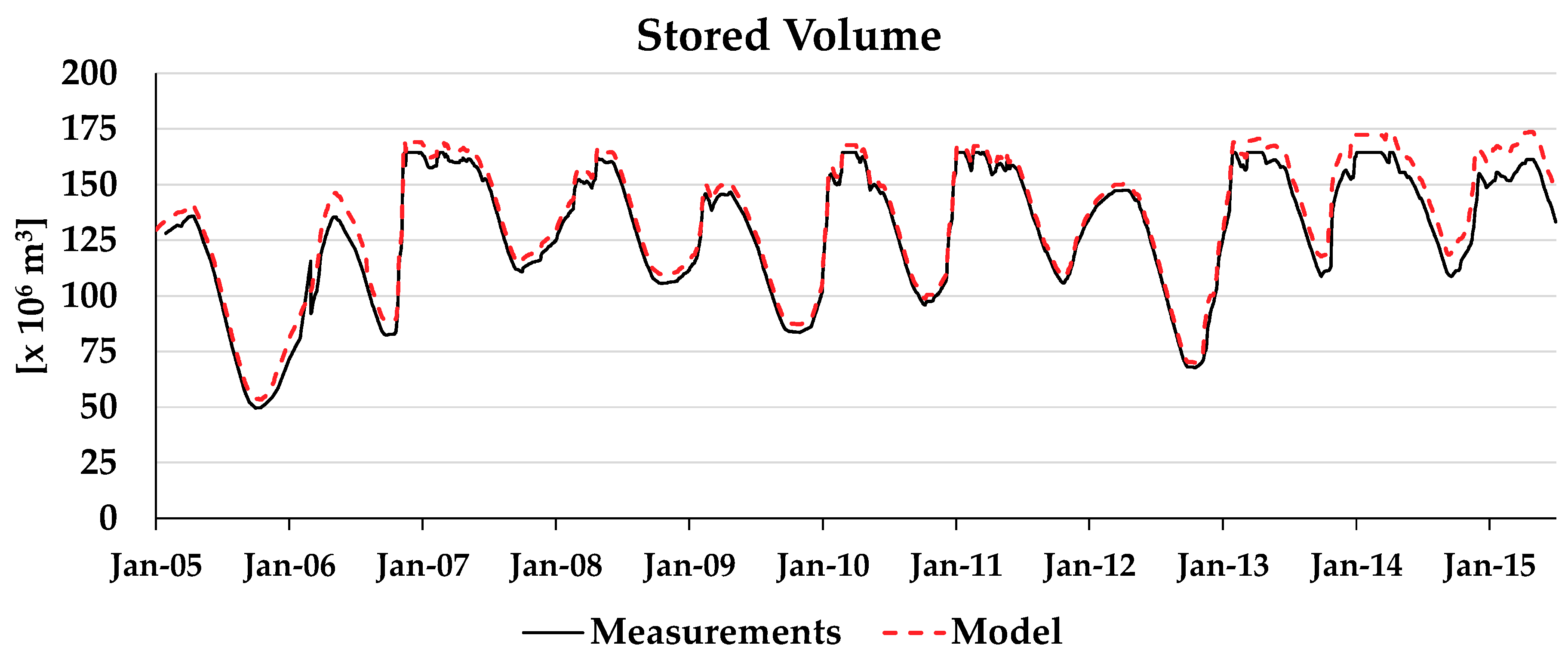
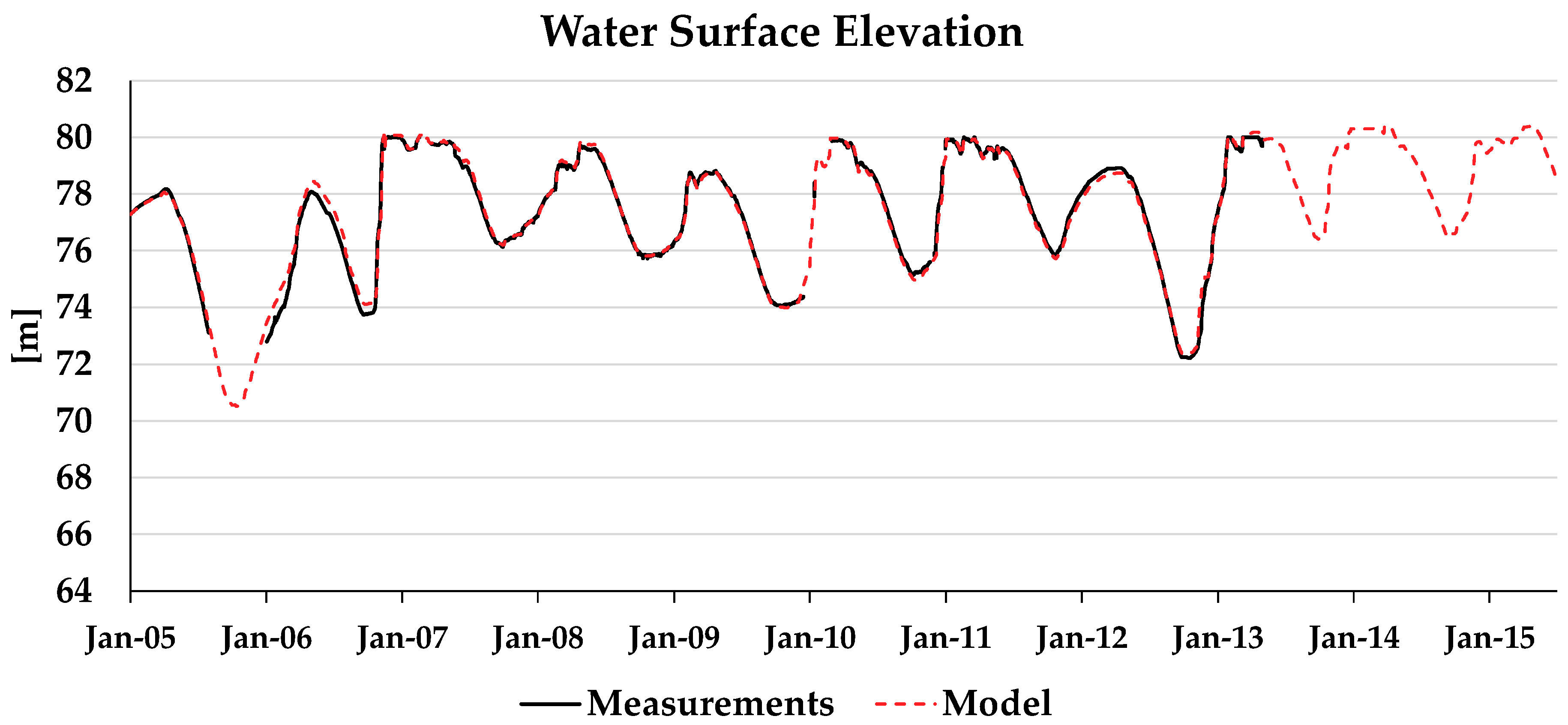
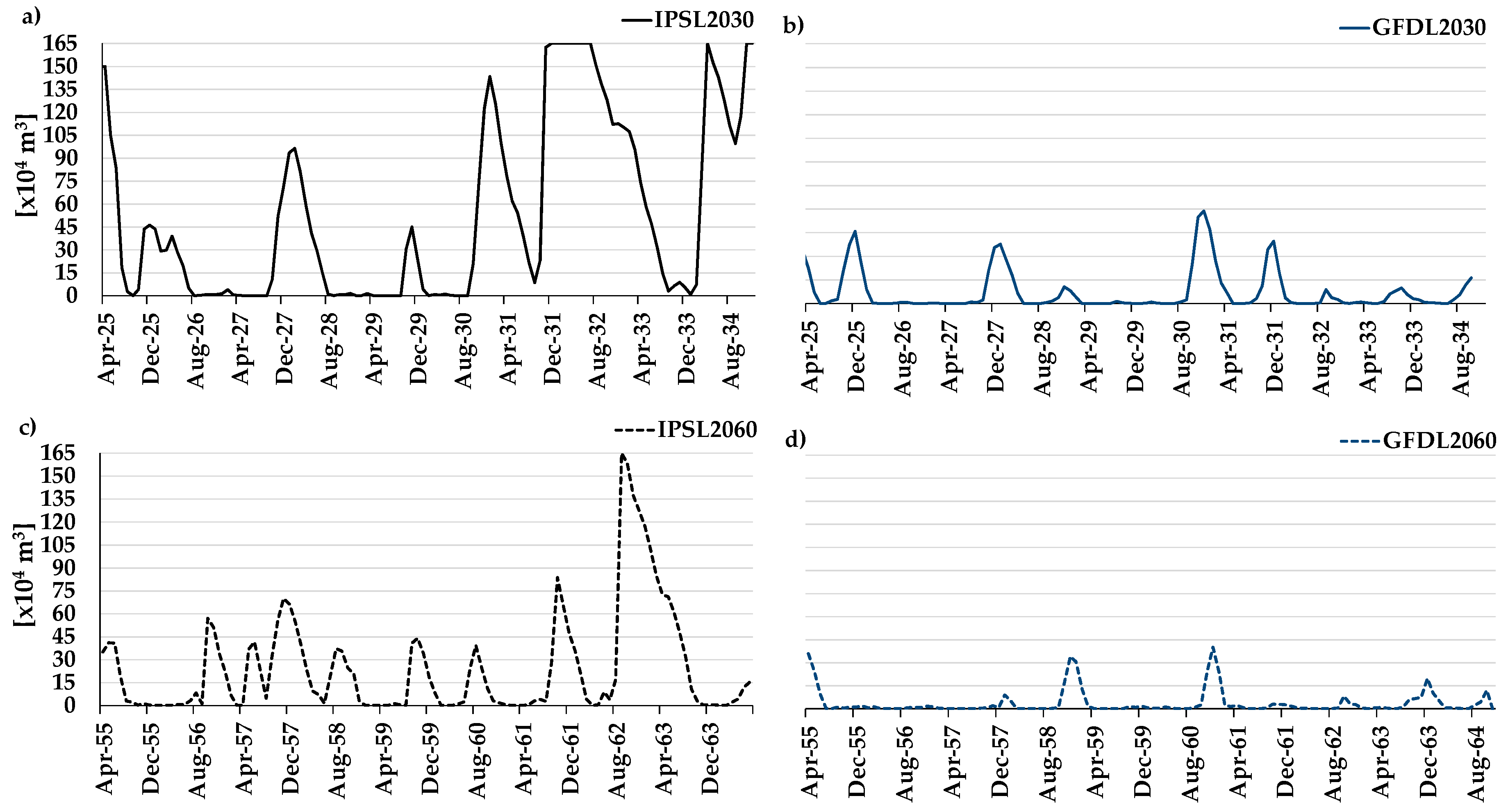
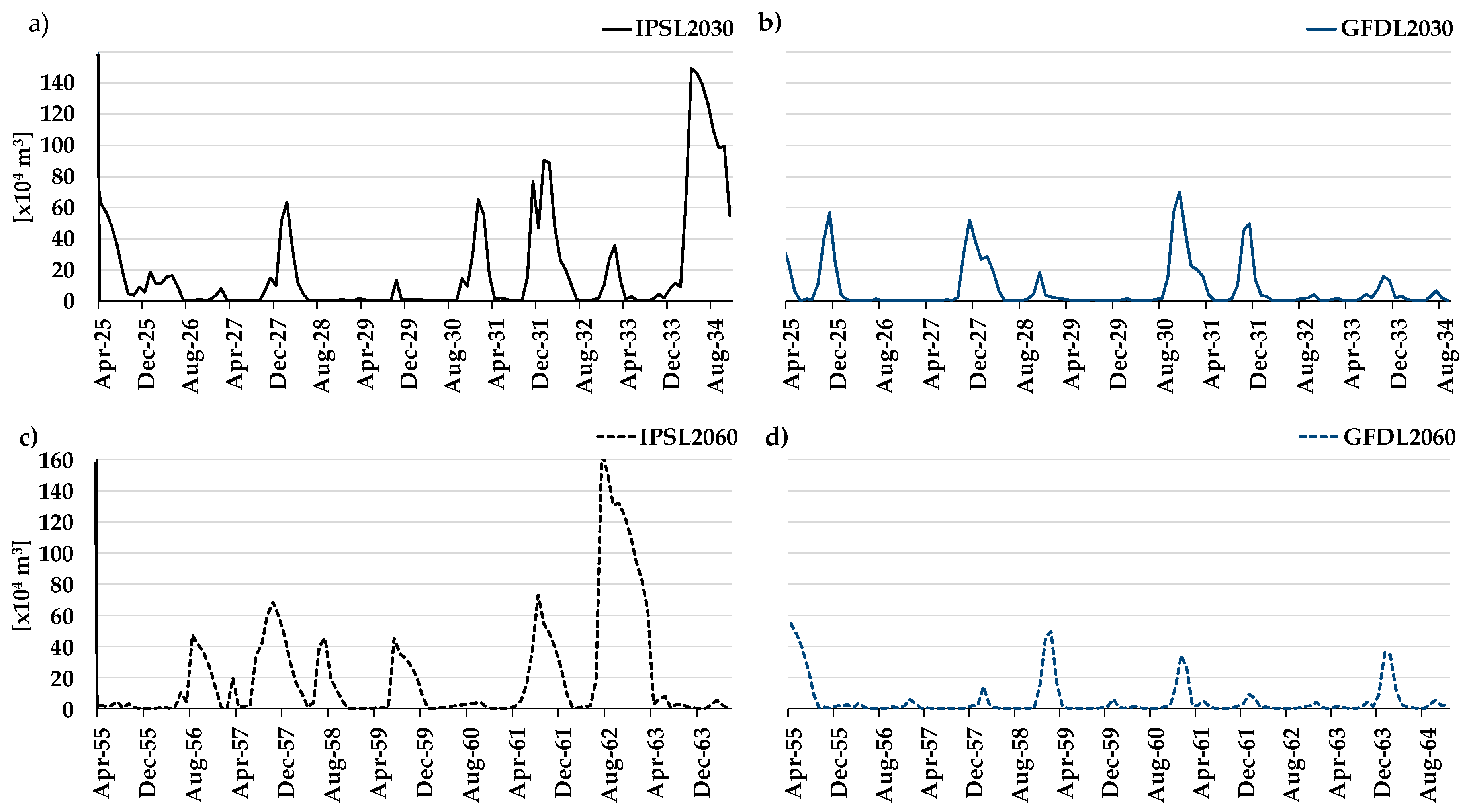
| Parameter | Description | Default | Calibrated Value |
|---|---|---|---|
| CN2 | SCS runoff curve number for moisture condition II. | 25 to 92 | 80 to 92 |
| ALPHA_BF | Baseflow alpha factor (1/days). | 0.048 | 1 |
| GW_Delay | Groundwater delay time (days) | 31 | 3 |
| SOL_AWC | Available water capacity of the soil layer (mm H2O/mm soil). | 0.11–0.14 | −40% |
| SOL_ZMX | Maximum rooting depth of soil profile. (mm). | - | 500 |
| SOL_Z1 | Depth from soil surface to bottom of first layer (mm). | 300 to 800 | slope 0–3%, to 800 slope 3–8%, to 500 slope >8%, to 300 |
| SOL_Z2 | Depth from soil surface to bottom of second layer (mm). | 300 to 800 | slope 0–3%, to 1000 slope 3–8%, to 800 slope >8%, to 500 |
| Scenario | IPSL 2030 | IPSL 2060 | GFDL 2030 | GFDL 2060 | |
|---|---|---|---|---|---|
| Number of months without failure | 88 | 88 | 59 | 52 | |
| Number of months with failure | 32 | 32 | 61 | 68 | |
| Reliability | Number of annual failures | 7 | 7 | 10 | 10 |
| Annual reliability (%) | 30 | 30 | 0 | 0 | |
| Vulnerability | Volumetric reliability (%) | 73 | 73 | 49 | 43 |
| Average duration of the failure (month) | 5 | 5 | 6 | 7 | |
| Resiliency | 9 | 9 | 12 | 14 | |
| Resiliency (%) | 28 | 28 | 20 | 21 | |
| Scenario | IPSL 2030 | IPSL 2060 | GFDL 2030 | GFDL 2060 | |
|---|---|---|---|---|---|
| Number of months without failure | 77 | 86 | 65 | 60 | |
| Number of months with failure | 43 | 34 | 55 | 60 | |
| Reliability | Number of annual failures | 9 | 8 | 10 | 10 |
| Annual reliability (%) | 10 | 20 | 0 | 0 | |
| Vulnerability | Volumetric reliability (%) | 64 | 72 | 54 | 50 |
| Average duration of the failure (month) | 5 | 4 | 6 | 6 | |
| Resiliency | 11 | 12 | 11 | 16 | |
| Resiliency (%) | 26 | 35 | 20 | 27 | |
© 2019 by the authors. Licensee MDPI, Basel, Switzerland. This article is an open access article distributed under the terms and conditions of the Creative Commons Attribution (CC BY) license (http://creativecommons.org/licenses/by/4.0/).
Share and Cite
Almeida, C.; Ramos, T.B.; Sobrinho, J.; Neves, R.; Proença de Oliveira, R. An Integrated Modelling Approach to Study Future Water Demand Vulnerability in the Montargil Reservoir Basin, Portugal. Sustainability 2019, 11, 206. https://doi.org/10.3390/su11010206
Almeida C, Ramos TB, Sobrinho J, Neves R, Proença de Oliveira R. An Integrated Modelling Approach to Study Future Water Demand Vulnerability in the Montargil Reservoir Basin, Portugal. Sustainability. 2019; 11(1):206. https://doi.org/10.3390/su11010206
Chicago/Turabian StyleAlmeida, Carina, Tiago B. Ramos, João Sobrinho, Ramiro Neves, and Rodrigo Proença de Oliveira. 2019. "An Integrated Modelling Approach to Study Future Water Demand Vulnerability in the Montargil Reservoir Basin, Portugal" Sustainability 11, no. 1: 206. https://doi.org/10.3390/su11010206
APA StyleAlmeida, C., Ramos, T. B., Sobrinho, J., Neves, R., & Proença de Oliveira, R. (2019). An Integrated Modelling Approach to Study Future Water Demand Vulnerability in the Montargil Reservoir Basin, Portugal. Sustainability, 11(1), 206. https://doi.org/10.3390/su11010206








